![[Digital logo]](../../IMAGES/DIGITAL-LOGO.GIF)
![[HR]](../../IMAGES/REDBAR.GIF)
![[Digital logo]](../../IMAGES/DIGITAL-LOGO.GIF)
![[HR]](../../IMAGES/REDBAR.GIF)
This appendix describes how OpenVMS Cluster systems support the Small Computer Systems Interface (SCSI) as a storage interconnect. Multiple Alpha computers, also referred to as hosts or nodes, can simultaneously access SCSI disks over a SCSI interconnect. Such a configuration is called a SCSI mulithost OpenVMS Cluster. A SCSI interconnect, also called a SCSI bus, is an industry-standard interconnect that supports one or more computers, peripheral devices, and interconnecting components.
The discussions in this chapter assume that you already understand the concept of sharing storage resources in an OpenVMS Cluster environment. OpenVMS Cluster concepts and configuration requirements are also described in the following OpenVMS Cluster documentation:
This appendix includes two primary parts:
Certain conventions are used throughout this appendix to identify the
ANSI Standard and for elements in figures.
A.1.1 SCSI ANSI Standard
OpenVMS Cluster systems configured with the SCSI interconnect must use
standard SCSI--2 components. The SCSI--2 components supported must be
compliant with the architecture defined in the American National
Standards Institute (ANSI) Standard SCSI--2. This standard defines
extensions to the SCSI--1 standard. For ease of discussion, this
appendix uses the term SCSI or SCSI--2 to refer to the SCSI--2
implementation as specified in the ANSI Standard SCSI--2 document
X3T9.2, Rev. 10L.
A.1.2 Symbols Used in Figures
Figure A-1 is a key to the symbols used in figures throughout this appendix.
Figure A-1 Key to Symbols Used in Figures
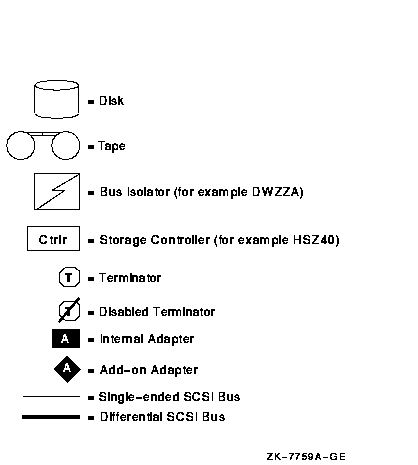
In OpenVMS Cluster configurations, multiple VAX and Alpha hosts can directly access SCSI devices in any of the following ways:
You can also access SCSI devices indirectly using the OpenVMS MSCP server.
The following sections describe single-host and multihost access to
SCSI storage devices.
A.2.1 Single-Host SCSI Access in OpenVMS Cluster Systems
Prior to OpenVMS Version 6.2, OpenVMS Cluster systems provided support
for SCSI storage devices connected to a single host using an embedded
SCSI adapter, an optional external SCSI adapter, or a special-purpose
RAID (redundant arrays of independent disks) controller. Only one host
could be connected to a SCSI bus.
A.2.2 Multihost SCSI Access in OpenVMS Cluster Systems
Beginning with OpenVMS Alpha Version 6.2, multiple Alpha hosts in an OpenVMS Cluster system can be connected to a single SCSI bus to share access to SCSI storage devices directly. This capability allows you to build highly available servers using shared access to SCSI storage.
Figure A-2 shows an OpenVMS Cluster configuration that uses a SCSI interconnect for shared access to SCSI devices. Note that another interconnect (for example, a local area network [LAN]) is required for host-to-host OpenVMS Cluster (System Communications Architecture [SCA]) communications.
Figure A-2 Highly Available Servers for Shared SCSI Access
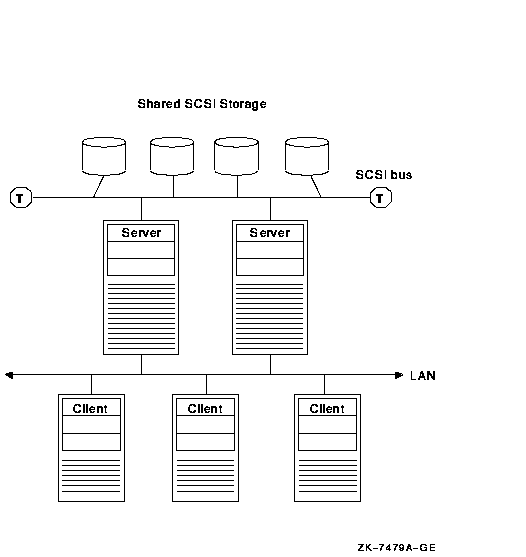
You can build a three-node OpenVMS Cluster system using the shared SCSI
bus as the storage interconnect, or you can include shared SCSI buses
within a larger OpenVMS Cluster configuration. A quorum disk can be
used on the SCSI bus to improve the availability of two- or three-node
configurations. Host-based RAID (including host-based shadowing) and
the MSCP server are supported for shared SCSI storage devices.
A.3 Configuration Requirements and Hardware Support
This section lists the configuration requirements and supported
hardware for multihost SCSI OpenVMS Cluster systems.
A.3.1 Configuration Requirements
Table A-1 shows the requirements and capabilities of the basic
software and hardware components you can configure in a SCSI OpenVMS
Cluster system.
| Requirement | Description |
|---|---|
| Software |
All Alpha hosts sharing access to storage on a SCSI interconnect must
be running:
|
| Hardware | Table A-2 lists the supported hardware components for SCSI OpenVMS Cluster systems. See also Section A.7.7 for information about other hardware devices that might be used in a SCSI OpenVMS Cluster configuration. |
| SCSI tape, floppies, and CD--ROM drives | You cannot configure SCSI tape drives, floppy drives, or CD--ROM drives on multihost SCSI interconnects. If your configuration requires SCSI tape, floppy, or CD--ROM drives, configure them on single-host SCSI interconnects. Note that SCSI tape, floppy, or CD--ROM drives may be MSCP or TMSCP served to other hosts in the OpenVMS Cluster configuration. |
| Maximum hosts on a SCSI bus | You can connect up to three hosts on a multihost SCSI bus. You can configure any mix of the hosts listed in Table A-2 on the same shared SCSI interconnect. |
| Maximum SCSI buses per host | You can connect each host to a maximum of six multihost SCSI buses. The number of nonshared (single-host) SCSI buses that can be configured is limited only by the number of available slots on the host bus. |
| Host-to-host communication | All members of the cluster must be connected by an interconnect that can be used for host-to-host (SCA) communication; for example, DSSI, CI, Ethernet, FDDI, or MEMORY CHANNEL. |
| Host-based RAID (including host-based shadowing) | Supported in SCSI OpenVMS Cluster configurations. |
| SCSI device naming |
The name of each SCSI device must be unique throughout the OpenVMS
Cluster system. When configuring devices on systems that include a
multihost SCSI bus, adhere to the following requirements:
|
Table A-2 shows the supported hardware components for SCSI OpenVMS Cluster systems; it also lists the minimum required revision for these hardware components. That is, for any component, you must use either the version listed in Table A-2 or a subsequent version.
The SCSI interconnect configuration and all devices on the SCSI interconnect must meet the requirements defined in the ANSI Standard SCSI--2 document and the requirements described in this appendix. See also Section A.7.7 for information about other hardware devices that might be used in a SCSI OpenVMS Cluster configuration.
| Component | Supported Item | Minimum Firmware (FW) or Hardware (HW) Version&185; | How to Find Your Version |
|---|---|---|---|
| Hosts | AlphaServer 400 | Console SHOW VERSION command | |
| AlphaServer 1000 | |||
| AlphaServer 2000 | |||
| AlphaServer 2100 | |||
| AlphaStation 200 | |||
| AlphaStation 250 | |||
| AlphaStation 400 | |||
| AlphaStation 600 | |||
| AlphaServer 8200 | |||
| AlphaServer 8400 | |||
| DEC 3000 | |||
| Disks² | RZ26 | Console SHOW DEVICE command | |
| RZ26L | 442D (FW) | ||
| RZ26N | |||
| RZ28 | 442D (FW) | ||
| RZ28B | 0006 (FW) | ||
| RZ28M | |||
| RZ29B | 0006 (FW) | ||
| Controller | HSZ40--B | 2.5 (FW) | Console SHOW DEVICE command |
| Bus isolators | DWZZA--AA | E01 (HW) | Examine product sticker |
| DWZZA--VA | F01 (HW) | ||
| DWZZB--VW | |||
| Adapters³ | Embedded (NCR-810 based) | ||
| KZPAA (PCI to SCSI) | |||
| KZPSA (PCI to SCSI) | A10 (FW) | ||
| KZTSA (TURBOchannel to SCSI) | A10-1 (FW) |
The SCSI standard defines a set of rules governing the interactions between initiators (typically, host systems) and SCSI targets (typically, peripheral devices). This standard allows the host to communicate with SCSI devices (such as disk drives, tape drives, printers, and optical media devices) without having to manage the device-specific characteristics.
The following sections describe the SCSI standard and the default modes
of operation. The discussions also describe some optional mechanisms
you can implement to enhance the default SCSI capabilities in areas
such as capacity, performance, availability, and distance.
A.4.1 Number of Devices
The SCSI bus is an I/O interconnect that can support up to 16 devices. A narrow SCSI bus supports up to 8 devices; a wide SCSI bus support up to 16 devices. The devices can include host adapters, peripheral controllers, and discrete peripheral devices such as disk or tape drives. The devices are addressed by a unique ID number from 0 through 15. You assign the device IDs by entering console commands, or by setting jumpers or switches, or by selecting a slot on a StorageWorks enclosure.
Note
In order to connect 16 devices to a wide SCSI bus, the devices themselves must also support wide addressing. Narrow devices do not talk to hosts above ID 7. Presently, the HSZ40 does not support addresses above 7. Host adapters that support wide addressing are KZTSA, KZPSA, and the QLogic wide adapters (KZPDA, ITIOP, P1SE, and P2SE). The QLogic wide adapters do not support a SCSI multihost OpenVMS Cluster configuration.
Although the maximum number of devices per SCSI bus has increased from 8 to 16, the SCSI bus length requirements have not changed. When configuring more devices than the previous limit of eight, make sure that you observe the bus length requirements (see Table A-4).
To configure wide IDs on a BA356 box, refer to the BA356 manual StorageWorks Solutions BA356-SB 16-Bit Shelf User's Guide (order number EK-BA356-UG). Do not configure a narrow device in a BA356 box that has a starting address of 8.
To increase the number of devices on the SCSI interconnect, some devices implement a second level of device addressing using logical unit numbers (LUNs). For each device ID, up to eight LUNs (0--7) can be used to address a single SCSI device as multiple units. The maximum number of LUNs per device ID is eight.
Note
When connecting devices to a SCSI interconnect, each device on the interconnect must have a unique device ID. You may need to change a device's default device ID to make it unique. For information about setting a single device's ID, refer to the owner's guide for the device.
The default mode of operation for all SCSI devices is 8-bit asynchronous mode. This mode, sometimes referred to as narrow mode, transfers 8 bits of data from one device to another. Each data transfer is acknowledged by the device receiving the data. Because the performance of the default mode is limited, the SCSI standard defines optional mechanisms to enhance performance. The following list describes two optional methods for achieving higher performance:
Because all communications on a SCSI interconnect occur between two devices at a time, each pair of devices must negotiate to determine which of the optional features they will use. Most, if not all, SCSI devices implement one or more of these options.
Table A-3 shows data rates when using 8- and 16-bit transfers with standard and fast synchronous modes.
| Mode | Narrow (8-bit) | Wide (16-bit) |
|---|---|---|
| Standard | 5 | 10 |
| Fast | 10 | 20 |
The maximum length of the SCSI interconnect is determined by the signaling method used in the configuration and, for single-ended signaling, by the data transfer rate. There are two types of electrical signaling for SCSI interconnects:
When considering cable distance issues, be sure to include both internal and external cabling in your calculations. Table A-5 lists the internal cable lengths for various configurations.
Table A-4 summarizes how the type of signaling method affects SCSI interconnect distances.
| Signaling Technique | Rate of Data Transfer | Maximum Cable Length |
|---|---|---|
| Single ended | Standard | 6 m¹ |
| Single ended | Fast | 3 m |
| Differential | Standard or fast | 25 m |
The DWZZA converter and the DWZZB converter are single-ended to differential converters that you can use to connect single-ended and differential SCSI interconnect segments. The difference between the DWZZA and the DWZZB is that the DWZZA is for narrow (8-bit) SCSI buses and the DWZZB is for wide (16-bit) SCSI buses. The differential segments are useful for the following:
Because the DWZZA and the DWZZB are strictly signal converters, you can
not assign a SCSI device ID to them. You can configure a maximum of two
DWZZA or two DWZZB converters in the path between any two SCSI devices.
A.4.4 Cabling and Termination
Each single-ended and differential SCSI interconnect must have two terminators, one at each end. The specified maximum interconnect lengths are measured from terminator to terminator.
The interconnect terminators are powered from the SCSI interconnect line called TERMPWR. Each Digital host adapter and enclosure supplies the TERMPWR interconnect line, so that as long as one host or enclosure is powered on, the interconnect remains terminated.
Devices attach to the interconnect by short cables (or etch) called stubs. Stubs must be short in order to maintain the signal integrity of the interconnect. The maximum stub lengths allowed are determined by the type of signaling used by the interconnect, as follows:
Additionally, the minimum distance between stubs on a single-ended interconnect is .3 m. Refer to Figure A-3 for an example of this configuration.
Note
Terminate single-ended and differential buses individually, even when using DWZZA converters.
When you are extending the SCSI bus beyond an existing terminator, it is necessary to disable or remove that terminator.
Figure A-3 Maximum Stub Lengths
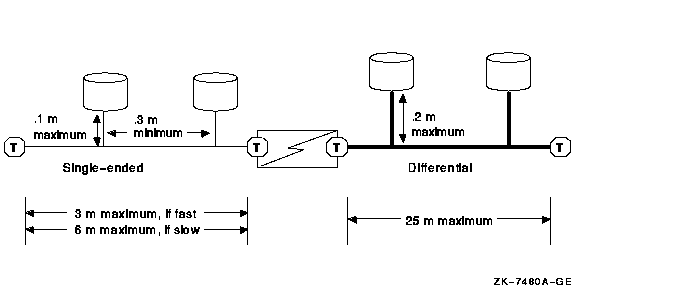
When using the host system's internal SCSI adapter, you must configure the system at the end of the single-ended SCSI segment. This is because the internal SCSI cable lengths exceed the allowable SCSI stub length. However, host systems are not required to be configured at the ends of the bus segment when an add-on SCSI adapter is used.
See Table A-5 for information about internal SCSI cable lengths.
A.5 SCSI OpenVMS Cluster Hardware Configurations
The hardware configuration that you choose depends on a combination of factors:
You can connect up to three hosts on a shared SCSI interconnect. Each host can be connected to as many as six shared SCSI interconnects. The number of nonshared SCSI buses that can be configured is specified in the particular device's documentation.
The following sections provide guidelines for building SCSI
configurations and describe potential configurations that might be
suitable for various sites.
A.5.1 Systems Using Add-On SCSI Adapters
Shared SCSI bus configurations can use optional add-on KZPAA, KZPSA, and KZTSA adapters. These adapters are generally easier to configure than internal adapters because they do not consume any SCSI cable length. Additionally, when you configure systems using add-on adapters for the shared SCSI bus, the internal adapter is available for connecting devices that cannot be shared (for example, SCSI tape, floppy, and CD--ROM drives).
When using add-on adapters, storage is configured using BA350, BA353, or HSZ40 StorageWorks enclosures. These enclosures are suitable for all data disks, and for shared OpenVMS Cluster system and quorum disks. By using StorageWorks enclosures, it is possible to shut down individual systems without losing access to the disks.
The following sections describe some SCSI OpenVMS Cluster
configurations that take advantage of add-on adapters.
A.5.1.1 Building a Basic System Using Add-On SCSI Adapters
Figure A-4 shows a logical representation of a basic configuration using SCSI adapters and a StorageWorks enclosure. This configuration has the advantage of being relatively simple, while still allowing the use of tapes, floppies, CD--ROMs, and disks with nonshared files (for example, page files and swap files) on internal buses. Figure A-5 shows this type of configuration using AlphaServer 1000 systems and a BA350 enclosure.
The BA350 enclosure uses 0.9 m of SCSI cabling, and this configuration typically uses two 1-m SCSI cables. (A BA353 enclosure also uses 0.9 m, with the same total cable length.) The resulting total cable length of 2.9 m allows fast SCSI mode operation.
Although the shared BA350 storage enclosure is theoretically a single point of failure, this basic system is a very reliable SCSI OpenVMS Cluster configuration. When the quorum disk is located in the BA350, you can shut down either of the AlphaStation systems independently while retaining access to the OpenVMS Cluster system. However, you cannot physically remove the AlphaStation system, because that would leave an unterminated SCSI bus.
If you need the ability to remove a system while your OpenVMS Cluster system remains operational, build your system using DWZZA converters, as described in Section A.5.1.2. If you need continuous access to data if a SCSI interconnect fails, you should do both of the following:
In Figure A-4 and the other logical configuration diagrams in this appendix, the required network interconnect is not shown.
Figure A-4 Conceptual View: Basic SCSI System
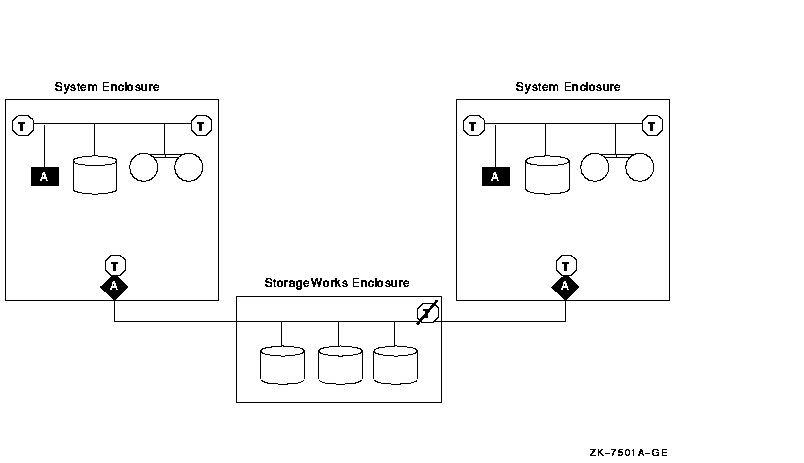
Figure A-5 Sample Configuration: Basic SCSI System Using AlphaServer 1000, KZPAA Adapter, and BA350 Enclosure
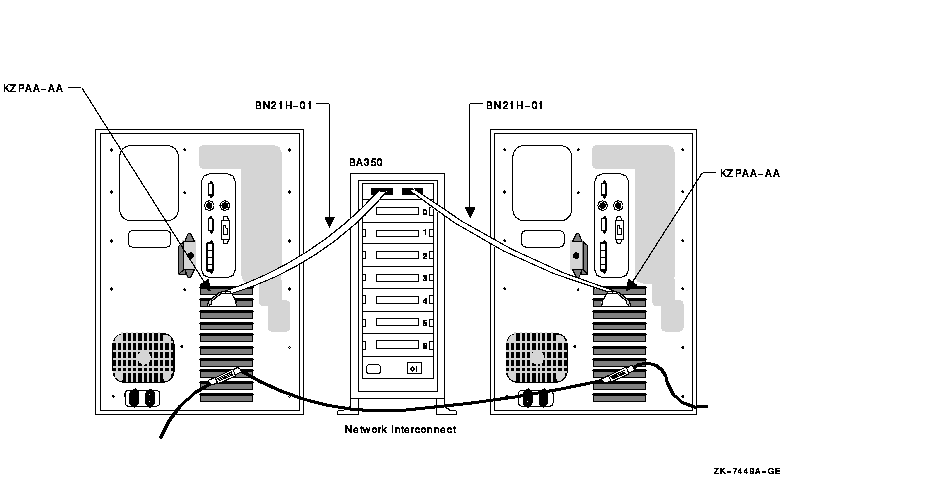
If you need additional enclosures, or if the needs of your site require a greater physical separation between systems, or if you plan to use HSZ controllers, you can use a configuration in which DWZZAs are placed between systems with single-ended signaling and a differential-cabled SCSI bus.
DWZZA converters provide additional SCSI bus length capabilities, because the DWZZA allows you to connect a single-ended device to a bus that uses differential signaling. As described in Section A.4.3, SCSI bus configurations that use differential signaling may span distances up to 25 m, whereas single-ended configurations can span only 3 m when fast-mode data transfer is used.
![[HR]](../../IMAGES/REDBAR.GIF)
6318P009.HTM OSSG Documentation 26-NOV-1996 11:20:25.43
Copyright © Digital Equipment Corporation 1996. All Rights Reserved.